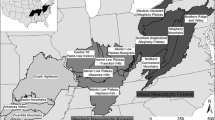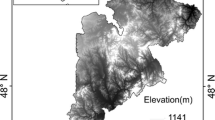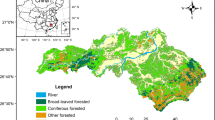Abstract
Context
Understanding how the Northern Forest landscape has changed and is likely to change, both in terms of forest extent and forest configuration, has important implications for management.
Objectives
We examined historical changes in forest pattern and extent to: (1) characterize recent forest cover change and potential drivers of that change, (2) identify areas vulnerable to future forest loss, (3) assess the impact of such loss on forest fragmentation, and (4) examine correlations between projected forest loss and socioeconomic variables to help inform future planning.
Methods
We developed a cellular automata model to simulate changes in forest land cover in the Northern Forest region from 2015 to 2075. The model was parameterized from observed historical trends (1985 to 2015) and correlating spatial variables using Bayesian Weights of Evidence. Using our model outputs, we identified areas most vulnerable to change, and impacts of these changes on forest fragmentation.
Results
Though we find an overall trend of decreasing forest area across the region, rates of change vary spatially and temporally, with an overall increase in forest cover between 2000 and 2015. Areas most attractive for development (e.g. high population density, low slope and elevation) were most likely to experience deforestation. Forest fragmentation increased during observed and simulated time steps, even during an observed period of net forest regeneration.
Conclusions
Forest loss and fragmentation due to development represent a formidable threat to the Northern Forest. Historical trends indicate that simply increasing forest extent is not sufficient to restore forest connectivity in the region.







Similar content being viewed by others
References
Allen JM, Leininger TJ, Hurd JD, Civco DL, Gelfand AE, Silander JA (2013) Socioeconomics drive woody invasive plant richness in New England, USA through forest fragmentation. Landscape Ecol 28:1671–1686
Beckage B, Osborne B, Gavin DG, Pucko C, Siccama T, Perkins T (2008) A rapid upward shift of a forest ecotone during 40 years of warming in the Green Mountains of Vermont. Proc Natl Acad Sci 105:4197–4202
Bliss JC, Kelly EC, Abrams J, Bailey C, Dyer J (2009) Disintegration of the U. S. Industrial Forest Estate: dynamics, trajectories, and questions. Small Scale For 9:53–66
Bormann FH, Likens GE (1979) Catastrophic disturbance and the steady state in Northern Hardwood Forests: a new look at the role of disturbance in the development of forest ecosystems suggests important implications for land-use policies. Am Sci 67:660–669
Brighton D, Fidel J, Shupe B (2010) Informing land use planning and forestland conservation through subdivision and parcelization trend information. Vermont Natural Resources Council, Montpelier
Cadenasso ML, Pickett STA (2001) Effect of edge structure on the flux of species into forest interiors. Conserv Biol 15:91–97
Dale V, Archer S, Chang M, Ojima D (2005) Ecological impacts and mitigation strategies for rural land management. Ecol Appl 15:1879–1892
de Paula MD, Costa CPA, Tabarelli M (2011) Carbon storage in a fragmented landscape of atlantic forest: the role played by edge-affected habitats and emergent trees. Trop Conserv Sci 4:349–358
Dixon RK, Solomon AM, Brown S, Houghton RA, Trexier MC, Wisniewski J (1994) Carbon pools and flux of global forest ecosystems. Science 263:185–190
Fahrig L, Girard J, Duro D, Pasher J, Smith A, Javorek S, King D, Lindsay KF, Mitchell S, Tischendorf L (2015) Farmlands with smaller crop fields have higher within-field biodiversity. Agric Ecosyst Environ 200:219–234
Federal Housing Finance Agency (2016) Percent Change in FHFA State-Level House Price Indexes (Seasonally Adjusted, Purchase-Only Index, 2016Q1): Maine, New Hampshire, New York, and Vermont. Federal Housing Finance Agency, Washington, DC
Galford GL, Soares-Filho BS, Sonter LJ, Laporte N (2015) Will passive protection save congo forests? PLoS ONE 10:e0128473
Germain RH, Anderson N, Bevilacqua E (2007) The effects of forestland parcelization and ownership transfers on nonindustrial private forestland forest stocking in New York. J For 105:403–408
Goward SN, Huang C, Zhao F, Schleeweis K, Rishmawi K, Lindsey M, Dungan JL, Michaelis A (2016) NACP NAFD Project: forest disturbance history from landsat, 1986–2010. ORNL DAAC, Oak Ridge
Gudex-Cross D, Pontius J, Adams A (2017) Enhanced forest cover mapping using spectral unmixing and object-based classification of multi-temporal Landsat imagery. Remote Sens Environ 196:193–204
Hansen AJ, Knight RL, Marzluff JM, Powell S, Brown K, Gude PH, Jones K (2005) Effects of exurban development on biodiversity: patterns, mechanisms, and research needs. Ecol Appl 15:1893–1905
Hansen MC, Potapov PV, Moore R, Hancher M, Turubanova SA, Tyukavina A, Thau D, Stehman S, Goetz SJ, Loveland TR, Kommareddy A, Egorov A, Chini L, Justice CO, Townshend JRG (2013) High-resolution global maps of 21st-century forest cover change. Science 342:850–853
Homer C, Dewitz J, Yang L, Jin S, Danielson P, Xian G, Coulston J, Herold ND, Wickham JD, Megown K (2015) Completion of the 2011 National Land Cover Database for the Conterminous United States-Representing a decade of land cover change information. Photogramm Eng Remote Sens 81:346–354
Huynh HTL, Pathirana A, Tran T (2016) Facing multiple challenges: the future of flooding in Can Tho city. VNU J Sci Earth Environ Stud 28:
IIED (2007) International Institute for Environment and Development Annual Report 2006/7: A World of Difference. IIED, London
Isbell F, Tilman D, Polasky S, Loreau M (2015) The biodiversity-dependent ecosystem service debt. Ecol Lett 18:119–134
Janowiak MK, D’Amato AW, Swanston CW, Iverson L, Dijak WD, Matthews S, Peters MP, Prasad A, Fraser JS, Brandt LA, Butler-Leopold P, Handler SD, Shannon PD, Burbank D, Campbell J, Cogbill C, Duveneck MJ, Emery MR, Fisichelli N, Foster J, Hushaw J, Kenefic L, Mahaffey A, Morelli TL, Reo NJ, Schaberg PG, Simmons KR, Weiskittel A, Wilmot S, Hollinger D, Lane E, Rustad L, Templer PH (2018) New England and northern New York forest ecosystem vulnerability assessment and synthesis: a report from the New England Climate Change Response Framework project. Gen Tech Rep NRS-173 Newtown Sq PA US Dep Agric For Serv North Res Stn 234 P 173:1–234
Kautz M, Anthoni P, Meddens AJH, Pugh TAM, Arneth A (2018) Simulating the recent impacts of multiple biotic disturbances on forest carbon cycling across the United States. Glob Change Biol 24:2079–2092
Kennedy RE, Yang Z, Cohen WB (2010) Detecting trends in forest disturbance and recovery using yearly Landsat time series: 1. LandTrendr—Temporal segmentation algorithms. Remote Sens Environ 114:2897–2910
Kennedy CM, Lonsdorf E, Neel MC, Williams NM, Ricketts TH, Winfree R, Bommarco R, Brittain C, Burley AL, Cariveau D, Carvalheiro LG, Chacoff NP, Cunningham SA, Danforth BN, Dudenhöffer J, Elle E, Gaines HR, Garibaldi LA, Gratton C, Holzschuh A, Isaacs R, Javorek SK, Jha S, Klein AM, Krewenka K, Mandelik Y, Mayfield MM, Morandin L, Neame LA, Otieno M, Park M, Potts SG, Rundlöf M, Saez A, Steffan-Dewenter I, Taki H, Viana BF, Westphal C, Greenleaf SS, Kremen C (2013) A global quantitative synthesis of local and landscape effects on wild bee pollinators in agroecosystems. Ecol Lett 16:584–599
Kolb M, Gerritsen PRW, Garduño G, Lazos Chavero E, Quijas S, Balvanera P, Álvarez N, Solís J, Olmedo Camacho (2018) Land use and cover change modeling as an integration framework: a mixed methods approach for the Southern Coast of Jalisco (Western Mexico). In: Camacho Olmedo MT, Paegelow M, Mas J-F, Escobar F (eds) Geomatic approaches for modeling land change Scenarios. Springer, Cham, pp 241–268
LANDFIRE (2014) Existing Vegetation Type Layer, LANDFIRE v 2.0.0. Department of the Interior, Geological Survey
Laurance WF, Lovejoy TE, Vasconcelos HL, Bruna EM, Didham RK, Stouffer PC, Cascon C, Bierregaard RO, Laurance SG, Sampaio E (2002) Ecosystem decay of amazonian forest fragments: a 22-year investigation. Conserv Biol 16:605–618
Lee J, Park B-J, Tsunetsugu Y, Ohira T, Kagawa T, Miyazaki Y (2011) Effect of forest bathing on physiological and psychological responses in young Japanese male subjects. Public Health 125:93–100
Leigh EG, Wright SJ, Herre EA, Putz FE (1993) The decline of tree diversity on newly isolated tropical islands: a test of a null hypothesis and some implications. Evol Ecol 7:76–102
LeVert M, Stevens T, Kittredge D (2009) Willingness-to-sell conservation easements: a case study. J For Econ 15:261–275
Liu Y, Feng Y, Zhao Z, Zhang Q, Su S (2016) Socioeconomic drivers of forest loss and fragmentation: a comparison between different land use planning schemes and policy implications. Land Use Policy 54:58–68
Mas J-F, Pérez-Vega A, Clarke KC (2012) Assessing simulated land use/cover maps using similarity and fragmentation indices. Ecol Complex 11:38–45
Matlack GR (1993) Microenvironment variation within and among forest edge sites in the eastern United States. Biol Cons 66:185–194
McGarigal K, Cushman SA, Ene E (2012) FRAGSTATS v4: patial pattern analysis program for categorical and continuous maps. University of Massachusetts, Amherst
Miller EK (2011) Steady-State Critical Loads and Exceedance for Terrestrial and Aquatic Ecosystems in the Northeastern United States. NPS/Multi Agency Critical Loads Project
Mockrin MH, Stewart SI, Radeloff VC, Hammer RG, Johnson KM (2013) Spatial and temporal residential density patterns from 1940 to 2000 in and around the Northern Forest of the Northeastern United States. Popul Environ 34:400–419
Morse CE, Strong AM, Mendez VE, Lovell ST, Troy AR, Morris WB (2014) Performing a New England landscape: viewing, engaging, and belonging. J Rural Stud 36:226–236
Murcia C (1995) Edge effects in fragmented forests: implications for conservation. Trends Ecol Evol 10:58–62
Nadrowski K, Wirth C, Scherer-Lorenzen M (2010) Is forest diversity driving ecosystem function and service? Curr Opin Environ Sustain 2:75–79
Nevins M (2019) Future forest composition under a changing climate and adaptive forest management in southeastern Vermont, USA. Graduate College Dissertations and Theses. University of Vermont
Nicholson CC, Koh I, Richardson LL, Beauchemin A, Ricketts TH (2017) Farm and landscape factors interact to affect the supply of pollination services. Agric Ecosyst Environ 250:113–122
O’Brien EA (2006) A question of value: what do trees and forests mean to people in Vermont? Landsc Res 31:257–275
Oliveira LJC, Costa MH, Soares-Filho BS, Coe MT (2013) Large-scale expansion of agriculture in Amazonia may be a no-win scenario. Environ Res Lett 8:24021
Oswald EM, Pontius J, Rayback SA, Schaberg PG, Wilmot SH, Dupigny-Giroux L (2018) The complex relationship between climate and sugar maple health: climate change implications in Vermont for a key northern hardwood species. For Ecol Manag 422:303–312
Oswalt SN, Smith WB, Miles PD, Pugh SA (2014) Forest Resources of the United States, 2012: A Technical Document Supporting the Forest Service Update of the 2010 RPA Assessment. United States Forest Service
Pan Y, Chen JM, Birdsey R, McCullough K, He L, Deng F (2012) NACP Forest Age Maps at 1-km Resolution for Canada (2004) and the U.S.A. (2006). Data set
Perz SG, Caldas MM, Arima E, Walker RJ (2007) Unofficial road building in the Amazon: socioeconomic and biophysical explanations. Development and Change 38:529–551
Polyakov M, Zhang D (2008) Property Tax Policy and Land-Use Change. Land Economics 84:396–408
Pontius J, Duncan J (2018) Linking science and management in a geospatial, multi- criteria decision support tool. New perspectives in forest science. New Perspectives in Forest Science, Multi- Criteria Decision Support Tool. https://doi.org/10.5772/intechopen.73083
PRISM Climate Group (2004) PRISM climate data
Riitters K (2002) Classification of Forest Fragmentation in North America
Schultz B, Hanson T, Wilmot S, Decker K, Greaves T (2014) Forest Insect and Disease Conditions in Vermont. Vermont Agency of Natural Resources, Vermont
Schwartz HM (2009) Subprime Nation: american power, global capital, and the housing bubble. Cornell University Press, Ithaca
Sieving KE, Karr JR (1997) Avian extinction and persistence mechanisms in lowland Panama. Trop For Remn Ecol Manag Conserv Fragm Communities University of Chicago Press, Chicago, pp 156–170
Soares-Filho BS, Coutinho Cerqueira G, Lopes Pennachin C (2002) DINAMICA—a stochastic cellular automata model designed to simulate the landscape dynamics in an Amazonian colonization frontier. Ecol Model 154:217–235
Soares-Filho B, Alencar A, Nepstad D, Cerqueira G, Vera Diaz M, Rivero S, Solórzano L, Voll E (2004) Simulating the response of land-cover changes to road paving and governance along a major Amazon highway: the Santarém-Cuiabá corridor. Glob Change Biol 10:745–764
Soares-Filho BS, Rodrigues HO, Costa W (2009) Modeling environmental dynamics with Dinamica EGO. Universidade Federal de Minas Gerais, Belo Horizonte, Minas Gerais, Brazil, Centro de Sensoriamento Remoto
Soares-Filho B, Moutinho P, Nepstad D, Anderson A, Rodrigues H, Garcia R, Dietzch L, Merry F, Bowman M, Hissa L, Silvestrini R, Maretti C (2010) Role of Brazilian Amazon protected areas in climate change mitigation. Proc Natl Acad Sci 107:10821–10826
Soares-Filho B, Rodrigues H, Follador M (2013) A hybrid analytical-heuristic method for calibrating land-use change models. Environ Model Softw 43:80–87
Thompson JR, Carpenter DN, Cogbill CV, Foster DR (2013) Four Centuries of Change in Northeastern United States Forests. PLoS ONE 8:e72540
Thompson JR, Plisinski JS, Olofsson P, Holden CE, Duveneck MJ (2017) Forest loss in New England: a projection of recent trends. PLoS ONE 12:e0189636
Thorn AM, Thompson JR, Plisinski JS (2016) Patterns and predictors of recent forest conversion in New England. Land. https://doi.org/10.3390/land5030030
U.S. Census (2010a) TIGER Population Dataset
U.S. Census (2010b) Urban areas boundaries
U.S. Census (2014) TIGER Roads Dataset
USGS (2015) eMODIS Phenology Metric data
USGS (2016) Protected Areas Database of the United States (PAD-US), version 1.4 Combined Feature Class
USGS (2017) The National Map
Ward J, Worthley T, Smallidge P, Bennett K (2013) Northeastern forest regeneration handbook: a guide for forest owners, harvesting practitioners, and public officials. USDA Forest Service, Newtown Square
Watson K (2018) Conservation of Ecosystem Services and Biodiversity in Vermont, USA. Graduate College Dissertations and Theses. University of Vermont
Wickham J, Stehman SV, Homer CG (2018) Spatial patterns of the United States National Land Cover Dataset (NLCD) land-cover change thematic accuracy (2001–2011). Int J Remote Sens 39:1729–1743
Wright JP, Jones CG, Flecker AS (2002) An ecosystem engineer, the beaver, increases species richness at the landscape scale. Oecologia 132:96–101
NRCS (n.d.) Web Soil Survey. Natural Resources Conservation Service, United States Department of Agriculture
Acknowledgements
This research was funded by the Northern States Research Cooperative (NSRC) through the U.S. Forest Service Northern Research Station, and the McIntire-Stennis Cooperative Forestry Program through the USDA National Institute of Food and Agriculture. The authors would like to thank Noah Ahles for his assistance in gathering and preparing data, and Jim Duncan for helpful feedback during the preparation of this manuscript.
Funding
This study was funded by the U.S. Department of Agriculture National Institute of Food and Agriculture, McIntire-Stennis project (grant number 1002440) at the University of Vermont, and by the U.S. Forest Service Northern Research Station, Northern States Research Cooperative (no grant number).
Author information
Authors and Affiliations
Corresponding author
Ethics declarations
Conflict of interest
The authors declare that they have no conflict of interest.
Additional information
Publisher's Note
Springer Nature remains neutral with regard to jurisdictional claims in published maps and institutional affiliations.
Electronic supplementary material
Below is the link to the electronic supplementary material.
Rights and permissions
About this article
Cite this article
Adams, A.B., Pontius, J., Galford, G. et al. Simulating forest cover change in the northeastern U.S.: decreasing forest area and increasing fragmentation. Landscape Ecol 34, 2401–2419 (2019). https://doi.org/10.1007/s10980-019-00896-7
Received:
Accepted:
Published:
Issue Date:
DOI: https://doi.org/10.1007/s10980-019-00896-7




